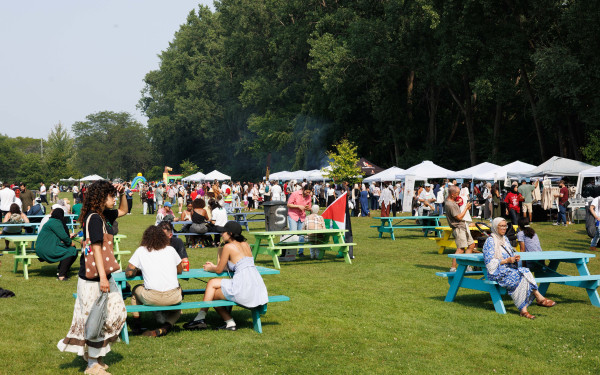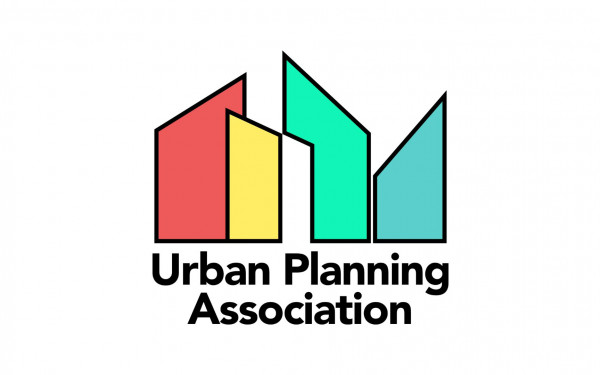Concordia’s Geography, Planning and Environment Department Designs Two Parks for Montreal
Charrettes Take the Community Stage
“What are you doing with the dog park?” a soft voice called out.
The collection of Concordia Geography, Planning and Environment students, gathered in Notre-Dame-de-Grâce-Park, fell into a rare silence.
Local resident Claire and her beagle Zoro were enjoying the early spring sunshine on March 12 when she overheard the group of students brainstorming a redesign at the base of the park’s chalet.
The city of Montreal invited the group of students to reimagine existing public spaces in the borough of NDG–Côte-des-Neiges, led by Concordia’s urban planning and design professor Silvano De la Llata, in conjunction with Université de Montréal. Their goal is to create two of the same spaces and structures in two different parks—Notre Dame de Grâce Park on Sherbrooke St. W. and Girouard Ave. and Kent Park in Côte-des-Neiges.
These structures—which are being fleshed out now—are meant to create a connection between the two areas, as a testament to the culture of the borough. The goal, De la Llata explained, is to have these new parks implemented by July 2017, just in time for Montreal’s 375th anniversary.
1_900_600_90.jpg)
Jasmine Ali, one of the student participants, explained that creating connectivity between neighbourhoods is a daunting, but important task.
“Essentially it’s one city, not two different neighbourhoods,” she said. “We want to bring back that unity.”
To do so, they’re turning to the history books. By focusing on the history of NDG–Côte-des-Neiges, the designers plan to instill a sense of connectivity, despite the 5.5 kilometres and cultural differences separating the two parks.
The Concordia organizers thought that this task couldn’t weigh only on their shoulders.
“We proposed that this should be a community exercise, not just a design exercise,” De la Llata said. Enter the concept of the charrette—in this context, a short but intense period of brainstorming in groups, encompassing urban planners, designers and regular park-users.
“We proposed that this should be a community exercise, not just a design exercise.” —Urban planning and design Professor Silvano De la Llata.
“I think the most important part is that we’re bringing in stakeholders,” continued De la Llata.
Ali said that the focus of their charrettes was bringing in a larger portion of the NDG–Côte-des-Neiges communities.
“It’s essential, because we can’t do anything without the public’s input,” she said. This is because it’s members of the public, like Claire and Zoro, who will be using these updated spaces. It’s important to make sure the new design works for them.
Working for the residents means understanding how they use and engage in the space. Because uses are so varied, the final product is akin to an expertly designed canvas. It becomes a space that is not limited to a single purpose, but is still self-contained.
Talks of possibly moving the stage in Notre Dame de Grâce Park generated a split vote that is representative of the larger divisive nature of these discussions.
“It’s good that there’s disagreement,” De la Llata admitted to a student following the debate. “It’s a part of the process. There are clashes.”
These clashes allow for the students to fully comprehend what De la Llata describes as “democratic urban design.”
“What we talk about all the time is this notion of the public democratizing, planning and making design accessible to the people,” he said.
In teaching urban planning, he draws upon the concept of placemaking that stems from architectural movements of the ‘60s and ‘70s. It’s the process of putting people first. Placemaking makes way for more than just the basic elements of urban planning—it allows a community’s needs and quirks to take centre stage.
While proposals were being thrown around, De la Llata reminded the group that “these are nobodies ideas. We are just facilitators.”
De la Llata insists that in order to teach these theories, his students must move outside of the classroom.
“The only way to teach is to enact it,” he said.
The experiential learning of the park design process grounds the concepts and actions that are being taught in coursework.
“It’s a part of the learning. Reaching a consensus is difficult and planning a space collectively is difficult,” De la Llata said. “It takes time.”

2_900_600_90.jpg)
_600_832_s.png)

_600_375_90_s_c1.jpg)

